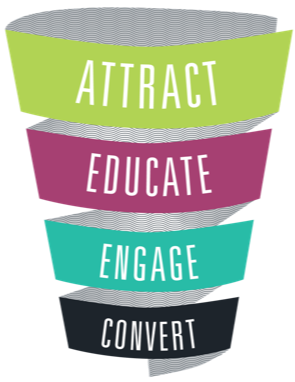
Content Marketing and Supporting the Sales Funnel
If you’re reading this blog on a web browser in the US, there is a 30%* chance that you’re using an adblocker right now (roughly twice as likely as in 2014*). It’s pretty clear that internet users aren’t fond of spammy advertising on the internet.
This is no surprise. Consider for a moment the digital world in which we live. It’s a world of tailored social media feeds, on-demand streaming video services and personalized, predictive search results. Everything we see is instantaneous, relevant, customized and high-quality. User’s expectaions have never been higher, so it should be obvious why the old spray-and-pray methods of advertising no longer hold water. If people aren’t simply ignoring it – they’re blocking it entirely.

For advertisers trying to jam messages down people’s throats, this is bad news. But for us marketers, the future has never been brighter. The key is deceptively simple: create stuff your customers actually want.
To be clear, there’s no single way to go about this. There are as many different content marketing strategies as there are different kinds of products, services, and target audiences. But one thing that nearly all of them have in common is the goal of creating and distributing content that is designed to support individuals through their buyer journey from attraction to conversion.
To see how this functions, Let’s use an example.
Let’s say you’re wanting to develop a content strategy for your company that sells treadmills.
After extensive persona and industry research, you feel you’ve created a plan that works to provide valuable and relevant content to your target audiences, right where they’re looking, in any given stage of the conversion funnel.
Here’s what a very simple version of that breakdown might look like:
Attraction: This content is made for people who have never heard of your brand, but want to get acquainted.
Key questions to answer with your content:
“How effective are treadmill exercises at encouraging weight loss?”, “are treadmills hard on my shins?”, or “is owning a treadmill cheaper than a gym membership?”
Types of content you might consider:
Native advertising, influencer marketing, YouTube series, paid search
Consideration: This content is made for people who have heard of your brand, and want to learn more to make an informed decision.
Key questions you might want to answer with your content:
“Which treadmill model is right for me?”, “what are the differences between brands?”, “what features will I use the most?”
Types of content you might consider:
Digital pre-roll, social media, blogs, infographics, interactive tools
Conversion: This content is made for people who are ready to make a purchase, and want to be assured.
Key questions you might want to answer with your content:
“Is now the best time to buy?”, “are there extra fees for delivery?”, “are there payment plans or warranties available?”
Types of content you might consider:
Web video, live chat, social media, email
Before, after and in between these various messages and delivery methods are virtually endless amounts of research, measurement, reporting and adjustment. Marketing capabilities are ever-changing and user expectations and habits are too. But the fundamental philosophy of content marketing is not new, and will never change: create stuff your customers actually want. Your users and your ROI will thank you.
*Source: eMarketer, 2017








